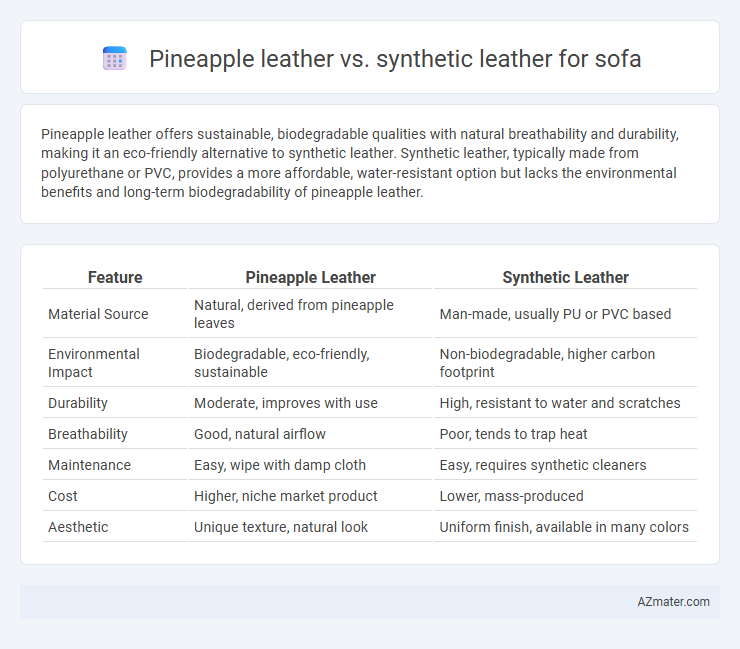Pineapple leather offers sustainable, biodegradable qualities with natural breathability and durability, making it an eco-friendly alternative to synthetic leather. Synthetic leather, typically made from polyurethane or PVC, provides a more affordable, water-resistant option but lacks the environmental benefits and long-term biodegradability of pineapple leather.
Table of Comparison
| Feature | Pineapple Leather | Synthetic Leather |
|---|---|---|
| Material Source | Natural, derived from pineapple leaves | Man-made, usually PU or PVC based |
| Environmental Impact | Biodegradable, eco-friendly, sustainable | Non-biodegradable, higher carbon footprint |
| Durability | Moderate, improves with use | High, resistant to water and scratches |
| Breathability | Good, natural airflow | Poor, tends to trap heat |
| Maintenance | Easy, wipe with damp cloth | Easy, requires synthetic cleaners |
| Cost | Higher, niche market product | Lower, mass-produced |
| Aesthetic | Unique texture, natural look | Uniform finish, available in many colors |
Introduction to Pineapple Leather and Synthetic Leather
Pineapple leather, also known as Pinatex, is an innovative, sustainable material made from pineapple leaf fibers, offering an eco-friendly alternative to traditional upholstery. Synthetic leather, commonly produced from polyurethane or polyvinyl chloride, provides durability and affordability but often lacks biodegradability and environmental benefits. Both materials serve as popular choices for sofa upholstery, balancing aesthetics, sustainability, and cost considerations.
Material Composition and Production Process
Pineapple leather, derived from the fibrous leaves of the pineapple plant, is a sustainable alternative to synthetic leather, which is typically made from polyurethane or polyvinyl chloride (PVC). The production of pineapple leather involves harvesting pineapple leaves, extracting fibers, and processing them into a biodegradable, eco-friendly material, while synthetic leather relies on chemical processes using petroleum-based plastics, resulting in higher environmental impact. This difference in material composition and production process makes pineapple leather more breathable and environmentally responsible compared to the less sustainable, plastic-based synthetic leather used in sofas.
Environmental Impact Comparison
Pineapple leather, derived from renewable pineapple leaves, offers a significantly lower environmental footprint by utilizing agricultural waste and reducing reliance on fossil fuels compared to synthetic leather, which is primarily made from petroleum-based plastics that contribute to pollution and non-biodegradability. The production of pineapple leather emits fewer greenhouse gases and minimizes waste, promoting sustainable agriculture and circular economy principles. In contrast, synthetic leather involves toxic chemical processing and generates microplastics, leading to long-term environmental harm and challenging disposal issues for sofas and other furniture.
Durability and Longevity Factors
Pineapple leather, made from sustainable Pina fibers, offers moderate durability but tends to be less resistant to wear and tear compared to synthetic leather, which is engineered for enhanced toughness. Synthetic leather typically withstands daily use better due to its strong polymer backing, making it more suitable for high-traffic environments. However, pineapple leather's biodegradability provides an eco-friendly option, although it may require more careful maintenance to extend its longevity.
Comfort and Aesthetic Appeal
Pineapple leather offers a soft, breathable texture that enhances sofa comfort by adapting to body heat and providing natural ventilation. Its unique grain pattern and subtle color variations create an organic, luxurious aesthetic distinct from the uniform finish of synthetic leather. While synthetic leather delivers consistent durability and easier maintenance, pineapple leather's eco-friendly origin and visually appealing surface make it a premium choice for stylish, comfortable sofas.
Maintenance and Cleaning Requirements
Pineapple leather offers a natural, breathable surface that requires gentle cleaning with a damp cloth and mild soap, making it eco-friendly and easy to maintain without harsh chemicals. Synthetic leather demands regular wiping to prevent dirt buildup and occasional use of specialized cleaners to avoid cracking or peeling over time. Both materials benefit from avoiding direct sunlight and sharp objects, but pineapple leather generally resists staining better due to its natural fibers.
Cost Analysis: Pineapple vs Synthetic Leather
Pineapple leather typically costs 20-30% more per square foot than synthetic leather due to its sustainable production process and natural materials. Synthetic leather offers a lower upfront cost, often priced between $15 to $25 per yard, while pineapple leather ranges from $25 to $35 per yard. Long-term value of pineapple leather may offset initial expenses through its durability and eco-friendly attributes, compared to synthetic leather's susceptibility to cracking and shorter lifespan.
Allergens and Hypoallergenic Properties
Pineapple leather, made from natural pineapple fibers, offers hypoallergenic properties by being free from common allergens found in synthetic materials, making it ideal for sensitive individuals. Synthetic leather often contains chemicals and plastics that can release irritants, increasing the likelihood of allergic reactions and skin sensitivities. Choosing pineapple leather for sofas ensures a more breathable, allergen-resistant surface that promotes indoor air quality and reduces allergen exposure.
Consumer Preferences and Market Trends
Pineapple leather, derived from sustainable Pinatex fibers, appeals to eco-conscious consumers valuing natural materials and environmental impact reduction. Synthetic leather remains popular due to its affordability, ease of maintenance, and variety in texture and color, catering to budget-focused buyers. Market trends indicate a growing demand for plant-based, cruelty-free alternatives like pineapple leather, especially in urban and millennial demographics prioritizing sustainability.
Final Verdict: Choosing the Best Sofa Upholstery
Pineapple leather, made from sustainable Pinatex fibers, offers eco-friendly durability and unique texture compared to synthetic leather's cost-effective, water-resistant surface but lower breathability. The choice depends on prioritizing environmental impact and natural aesthetics versus budget and maintenance ease. For sustainable, stylish living spaces, pineapple leather stands out, while synthetic leather suits practical, affordable upholstery needs.

Infographic: Pineapple leather vs Synthetic leather for Sofa
 azmater.com
azmater.com